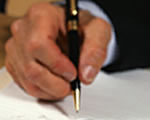 Go to main content
Go to main content
Archive Website of the UK government
Please note that this website has a UK government accesskeys system.
Main menu
Page menu
Home and community

Registering land or property

You need to register almost all land or property that you buy or are given with Land Registry. Most people use a solicitor or conveyancer to do this, but you can do it yourself. Find out when you have to register land and how to do it.
Registering land or property – the basics
Registering your land or property with Land Registry:
- shows proof of ownership
- helps to protect your land if someone tries to make a claim on it
- makes changes in ownership easier
You can register land or property yourself, although most people use a solicitor or conveyancer. Your mortgage provider might insist that you use a professional. Land Registry can’t give you legal advice about your application.
If the land or property is in Scotland or Northern Ireland, registration is not done by Land Registry. See the links below.
When to register land or property
You must register land or property in your name if you have taken over the ownership from someone else (for example, you've inherited a property). This is known as 'transferring ownership'.
You must also register land or property if:
- it's sold to you
- it's given to you
- you lease it and there's seven or more years left on the lease
In some cases, you might also need to register land that is leased to you for less than seven years. Contact Land Registry if you aren’t sure whether you need to register your land.
Voluntary first registration
Even if you aren't legally required to register your land or property, you can voluntarily register it at any time.
How to transfer ownership/register land or property
Transferring ownership of registered land
Fill out form AP1 and one of these two forms:
- form TR1 if you are transferring a whole registered title
- form TP1 if you are transferring part of a registered title
Registering land or property for the first time (‘first registration’)
Fill out these forms:
- form TR1
- form FR1
- form DL (you’ll need two copies of this form)
You also need to include the following:
- information so Land Registry can find the land on the Ordnance Survey map - for example, a plan of where the land is
- the original deeds and documents of title
- the original and a copy of the lease if you are applying to register a leasehold land or property
- results of your searches from the Land Charges Department – you can use form K15 for these searches
It will be harder for you to register your land or property for the first time if any of the original deeds are missing. Contact Land Registry for advice if this is the case.
Other documents you need to send
When applying to register your land or property, you might also need to send:
- form ID1 (proof of identity)
- form DI if you are declaring ‘overriding interests’
- a Land Transaction Return certificate if you have paid Stamp Duty Land Tax, issued by HMRC
- a cheque or postal order for the registration fee, see below
Costs of registering land or property
You'll have to pay a fee to register any land or property. The amount depends on:
- how much your land or property is worth
- whether your registration is compulsory or voluntary
If you register your land or property voluntarily for the first time, you could receive a discount of 25 per cent on the registration fee. Contact Land Registry for the current fees.
Where to send your Land Registry forms
The Land Registry office you need to apply to might not be the one that is closest to you. Use Land Registry’s office finder to find out which office to send your forms to.

